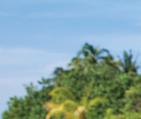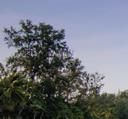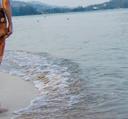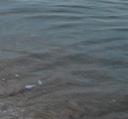REPURPOSING FOR OUR ENVIRONMENTAL FUTURE

Q1

Lenox Metals diverts nearly 10 million pounds of industrial commercial scrap metals out of Hawaii’s landfill per year!






Q1

Lenox Metals diverts nearly 10 million pounds of industrial commercial scrap metals out of Hawaii’s landfill per year!




 BY: EMMA WILLIAMS
BY: EMMA WILLIAMS
When he first arrives on a new job site, Alan Hornstein, founder of Lenox Metals, always asks, “Can you repurpose that item or use it in your operation somewhere?” Only when he knows the customer cannot use it does he set up services to reclaim the scrap.

Raised in the scrap reclamation business, Hornstein arrived in Oahu in 1979. He likes to joke he was dropped off by a container ship on the docks by Aloha Tower. The truth may be a little more ordinary, but once he arrived here his career has been anything but. His first job was with the telephone company where local managers took him under their wing and told him to take it slow and learn local ways. He did just that. As a supply management manager with the phone company, he created a metal recycling program that had $2 million in sales in one year alone.
After a quick rise with rapidly increasing responsibility at the utility company, Hornstein set out on his own and opened a scrap metal reclamation center which he named Lenox Metals. The company quickly outgrew its first location; within a few years, he leased the spot where
Lenox Metals has stood for the last 21 years. The facility is modeled after the scrap reclamation facility where Hornstein first worked as a teenager with his uncles. From them he learned the business from the ground up. His facility is kept scrupulously clean and that same ethos of cleaning up after any spill or mess is carried to every Lenox Metals job site.
With more than 35 years of experience, Lenox Metals has built relationships with project managers and companies all over the island and the mainland. In an industry that often still operates on a handshake, these relationships are of the utmost importance. They serve to enable Lenox Metals to be a trusted partner at both ends of the deal.
Last year, Lenox Metals recycled nearly 10 million pounds of metal from our islands. This means the scrap is reused and repurposed instead of ending up in a landfill. Lenox Metals also plays a vital role in supporting American industry. Not only does the company remove metals from job sites and industrial facilities, it provides the raw materials that go into creating new products.
For example, only three mines in the U.S. produce over a hundred-thousand tons of copper annually, which does not come close to providing all the copper needed for the nation’s manufacturing. Copper is important for everything from semiconductors to medical products to the wiring of residences. By carefully collecting copper from local demolition projects, Lenox Metals is able to ensure the continued supply of this important metal in industries across the country. This process is repeated with all the metals the company handles.

At Lenox Metals, professional staff strive to meet and surpass all safety standards. Many employees have been with the company for over 10 years and some since almost the beginning. The staff bring a wealth of institutional knowledge to each job site. Their goal is to avoid all pollution while customers can be assured that all scrap will be handled legally, ethically, and discreetly. Everything repurposed keeps scrap out of our landfills and puts materials in the hands of manufacturers who can give it new life as a new product.
In the years Lenox Metals has been open, how have perceptions about the recycling industry changed? Years ago, recycling may have been viewed as inconvenient and unnecessary. Today, it is a completely different perception. Recycling is viewed as important to divert materials from landfills and help preserve our environment. In our industry, industrial and commercial metal recycling, there is increased awareness of not only the environmental benefits of recycling but the monetary rewards as well. Items containing copper, brass, aluminum, stainless steel, and other metals may provide substantial rebates to our customers. The key is to make recycling as easy as possible where it becomes routine in a company’s operations.
Why is Lenox Metals able to provide better services than its competitors?
Lenox strives to distinguish itself by focusing on our customers’ needs and how to put them in a position to be successful with their recycling program or project. This involves asking questions and listening to what they have to say. It also may involve thinking “outside of the box” so we may provide a solution to overcome a difficult obstacle. At Lenox, service is extremely important to us. We also continuously search for the best markets and outlets for recyclable metals. These outlets can be on the mainland or international locations. This allows Lenox to provide the maximum rebate to our customers in an ever-changing marketplace.
How much of a difference has Lenox Metals made in our islands over the past decades?
During its 35-plus years in Hawaii, Lenox Metals has helped increase the awareness of commercial and industrial customers that their recyclable metals are valuable and should be recycled rather than disposed of in landfills. This has resulted in more metal containing materials being recycled and less landfilled.


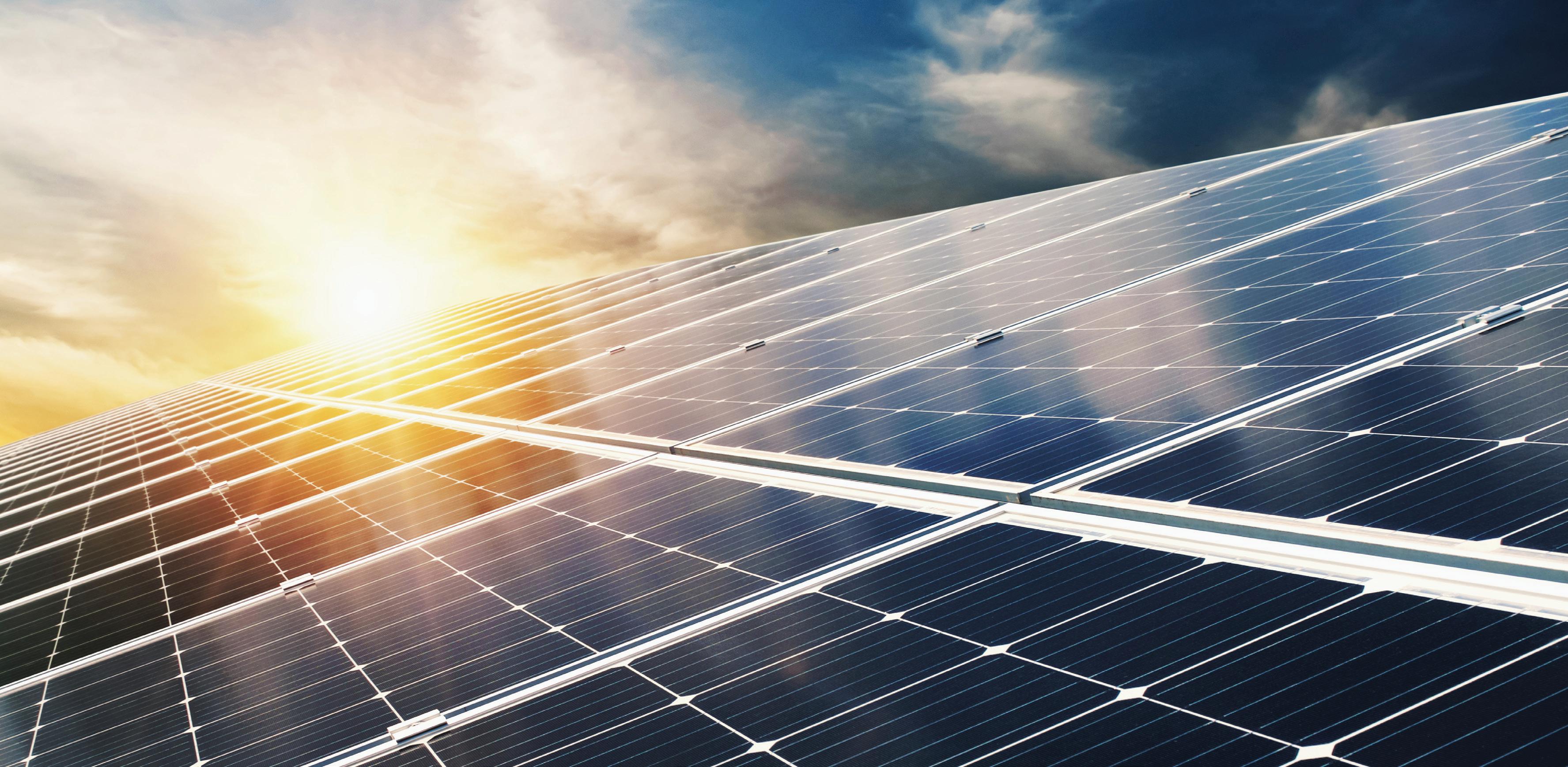


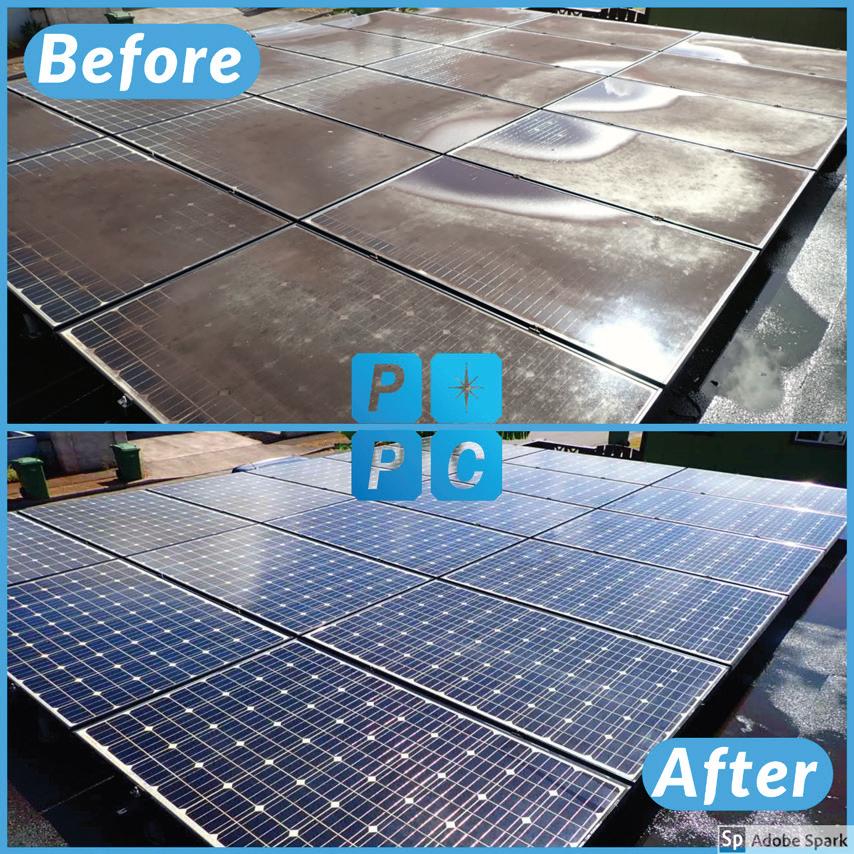



Palmer was surrounded by pop culture portraits in his parent’s home while growing up in LA. This influence, as well as LA’s surf & skate culture, led him to begin creating graffiti art at the age of 13.

“I try to keep it funky and not perfect,” states Palmer whose art features anything from license plates and street signs to police tape and diamond dust.

In 1989, Palmer moved to the island of Kauai for the surf. By the early 2000’s all of his surroundings and early influences came together allowing him to create pieces that you see in his art today.
“I like to get a reaction out of people,” states Palmer regarding the goal of his art.
Palmer can be found hopping on a plane fairly often, hoping to catch his next big wave. As a self-proclaimed thrill seeker, he travels to Tahiti, Bali, Western Samoa, and Mexico. He frequently travels to LA for inspiration and tends to revisit original style influences he grew up with.
Among the many inspirational and exotic features of the island of Kauai is long time resident, Craig Palmer’s art creations.
When globe-trotter Palmer isn’t enjoying the surf you will find him snowboarding in Japan every winter. “The mountains call every so often and I’ve gotta go,” states Palmer.
Palmer’s piece, Modern Geisha, was inspired by his experiences in Japan.

Like most creative talents, Palmer states that his mood also inspires his pieces.
“If I’m feeling relaxed I will create a more tranquil piece but I also switch and design a chaotic piece when my mind is stimulated or I’m feeling impulsive,” states Palmer, “sometimes I may even turn a little bit of chaos into harmony depending on my mood.”
Palmer has not always been able to dive head first into his art as easily as he can today. Eighteen years ago, he found himself a single father slowing down his works for a bit while allowing himself the enjoyment of parenthood. He never lost his passion for creating art and continued to do so throughout the years with more to come.

Most recently, Palmer entered a piece titled Layla into the Kauai Society of Arts Show 2019. Out of 174 entries, his was one of the 74 pieces selected to be featured throughout the island in places such as the Lihue Airport and local libraries.

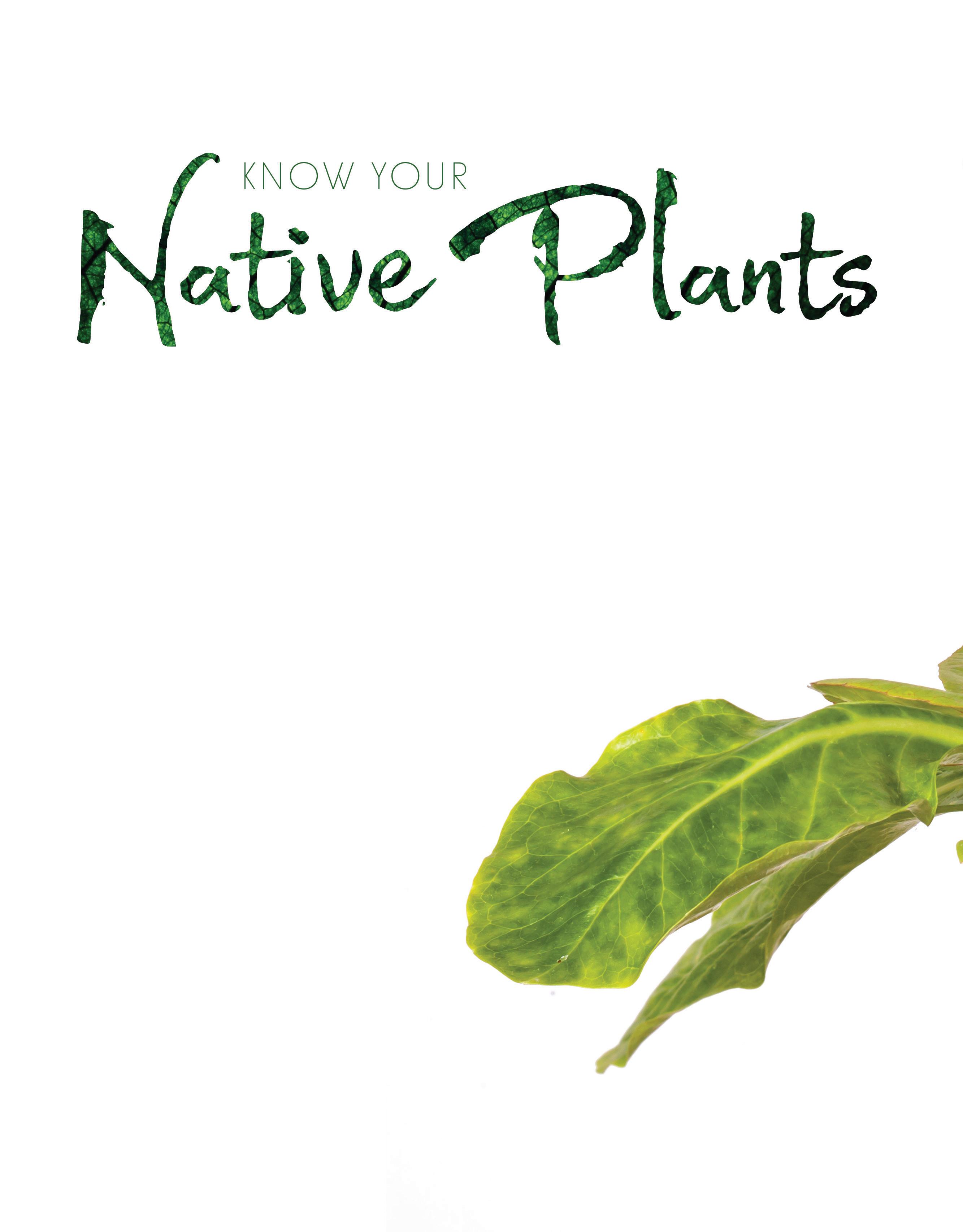 By Kevin Whitton Photos Darryl Watanabe
By Kevin Whitton Photos Darryl Watanabe
Rick Barboza and Matt Schirman, coowners of native Hawaiian plant nursery Hui Kū Maoli Ola, are on a mission to reintroduce native Hawaiian plants into the suburban landscape. Since 2005, they’ve been growing them at their He‘eia nursery in Ha‘ikū Valley and educating landscapers
and backyard-gardening enthusiasts about the care and importance of these environmentally and culturally significant species. To this day, they hear the same gripes about native Hawaiian plants—that they’re ugly, slow growing and difficult to keep alive.
The two native Hawaiian plant specialists are adamant that these misconceptions stem from a lack of knowledge about the specific growing conditions that native Hawaiian plants require. Most residential areas have been cleared of their naturally occurring native vegetation. If you’re looking to landscape
SCIENTIFIC NAME: BRIGHAMIA INSIGNIS
DESCRIPTION: Small to medium shrub with a fat, succulent stalk—sometimes branched—that produces a rosette of large, rounded, light green leaves. Grows up to six feet tall and three feet wide. Small, star-shaped yellow flowers protrude from the leaf axis on long stems. Blooming is sporadic. When in bloom, its fragrant flowers can completely encircle the top of the plant, resembling a crown.
LANDSCAPE USE: Shrub, accent, container. Plant alula in dry areas with full sun. Soil should dry out completely between watering.
with native Hawaiian plants, you need to pick them based on where you live. You wouldn’t want to plant beach plants in the back of Mānoa Valley, and you would definitely kill a hapu‘u tree fern if you planted it on the windward side of a beach house. The trick to maintaining a beautiful landscape of native Hawaiian plants is to learn about the plants that once grew in the area, so you can then mimic that biodiversity. Done properly, nature will take care of most of the plants’ needs once they are established.


Hawai‘i is home to approximately 1,500 native plant species, 90 percent of which are endemic.
SCIENTIFIC NAME: DIANELLA SANDWICENSE

DESCRIPTION: ‘Uki‘uki has two forms: short, compact growth with dark green leaf blades about a foot tall and less compact growth with lighter green foliage up to three feet tall. When in bloom, the short form sends up a short, central stalk covered with small purple and yellow flowers that develop into dark purple berries. The taller form sends up a stalk with many small white and yellow flowers. Both forms bloom year round.
LANDSCAPE USE: Ground cover, accent plant, container. Plant ‘uki‘uki in full sun to partial shade. Requires light to moderate watering.
Hawai‘i indigenous plants are native to Hawai‘i as well as other parts of the world— think naupaka kahakai.
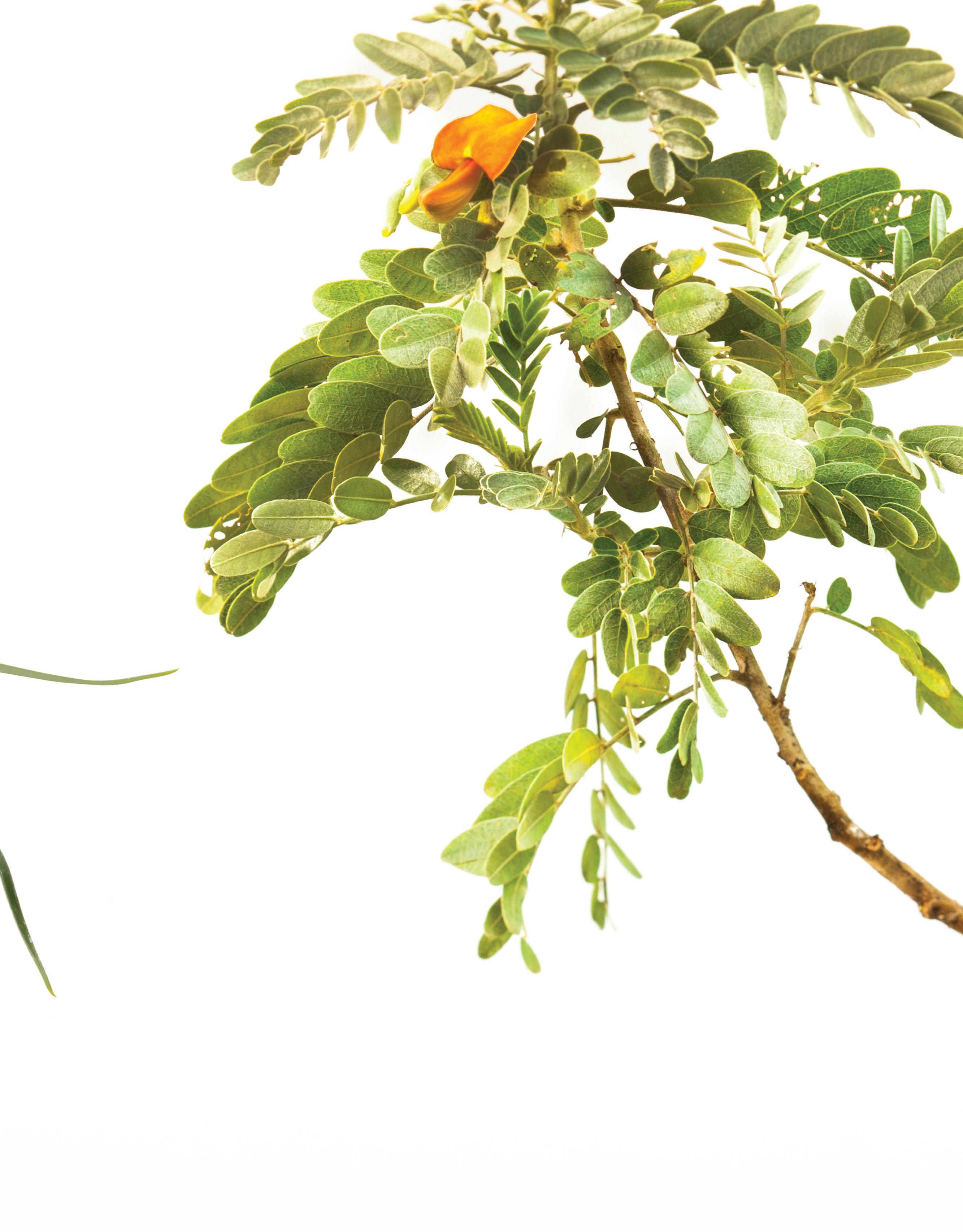
Hawai‘i endemic plants are native only to Hawai‘i—think koa trees. Hawai‘i’s endemic plants arrived by wing, wind or waves before the arrival of Captain Cook and gradually evolved into new species shaped by its environment, predators and pollinators.
Of the approximately 20,000 plant species introduced into Hawai‘i over the last 200 years, 8,000 have become naturalized—they are established and growing on their own in nature.
SCIENTIFIC NAME: SESBANIA TOMENTOSA

DESCRIPTION: Partially woody, lowsprawling shrub with extremely soft, silvery-pubescent pinnate leaves that help reflect sunlight and retain moisture. Leaves at the stem tips are highly aromatic in full sun. Striking pink and yellow pea flowers, each about one to two inches in length, form in clusters under the leaves. ‘O - hai blooms sporadically throughout the year with peak blooming periods following heavy rain in winter and spring. Long, greenish bean pods form after flowering.
LANDSCAPE USE: Shrub, tree, accent, hedges, screening. Plant ‘o - hai in full sun in well-draining soil. Prefers dry growing conditions and is generally tolerant of wind. ‘O - hai enriches the soil with nitrogen, benefiting neighboring plants.

In the next 10 years, what do you hope to see in your industry?
It’s such an exciting time to be in the energy sector! Particularly as someone who embraces change, I love the transformation to a decarbonized future. At Hawaii Gas, due partly to our isolation in the middle of the Pacific Ocean, innovation has long been the company’s mantra. A little-known fact locally: HG is a global leader in the use of hydrogen in our pipeline fuel mix, a carbon neutral fuel that’s been an integral part of our business for decades. We continue to develop our hydrogen and renewable natural gas initiatives and see it as a major part of our clean energy future. Our SNG is another example—recycling a byproduct that had no useful value and creating synthetic natural gas over 20 years ago, long before recycling waste products was commercially viable. When you live and work on an island, you figure out how to make it work.
What do you love most about your job?
I’m one of those people who embraces change. I get bored otherwise! The energy and utility sectors are in the midst of major and vitally important change, and I’m honored to be at some of those tables. Being there as we cultivate new renewable energy innovations, as we take a hard look at our sustainability and figure out what changes we can make, what markers we need to meet, advancements that can be made to meet the state’s clean energy goals, and so much more. In life, sometimes it’s only in hindsight that we realize we were in the midst of something major. In energy and environment right now, we know it in real time. We’ve got to get this right.
I’ve been fortunate enough to work for a wonderful female CEO who has really supported me in leading the charge for developing and releasing the first annual Sustainability Report by Hawaii Gas. It’s definitely been one of the biggest and most important projects I’ve ever undertaken, and I’m incredibly proud of the company and the final report we’ve released.
What has been the biggest sacrifice you’ve made for your career?
I’m like most of us. I’m balancing life and family and career and still trying to keep all the balls in the air at all times. Early in my career when we lived in San Diego, I received a huge promotion, which of course I was thrilled about. But it soon became obvious I couldn’t do it all. My son, now 15, was still very young, and my career was dramatically and adversely impacting our family life. So I did what I knew was right—I stepped down from that promotion to have more of me for my family. I’ve never regretted that decision. All these years later, I know now what I didn’t know then. Our careers have a long runway, often paved by the women who’ve come before us. We may not be able to do everything all at once, but we can make meaningful and important impacts in both our jobs and our families.
What failure taught you the biggest lesson?
It’s not a failure per se, but a life event. While I was on the Big Island for a business conference, our house on O‘ahu burned to the ground. My husband called me of course, to report that he, our son, and our dogs were fine, and I caught the first plane home. My initial reaction was similar to my husband’s—we’re all fine. I’m fine. We’ve got this. But it was a lot to process, and I wasn’t the same high-functioning professional or wife or parent than I normally was.
During that entire period, so many women friends, including my core group of amazing girlfriends and my newly fostered sisters in the Patsy Mink
Leadership Program reached out, offered help, introduced valuable resources, and sometimes just made me laugh. I realize now those “amazing women” helped me navigate one of the hardest challenges I’ve ever faced. Women know. They understand. And even in the most elevated, prestigious leadership positions in the state, we are still moms and wives and sisters and daughters.
As you reflect back on your life and career, would you change anything personally or professionally?
This is something I think about all the time—what would I have done differently. You can constantly think about how you could have done this or that better. But this is one where I stop myself and look around at the life I have built. I have a wonderful husband, and amazingly smart, resilient and well adjusted son, great friends and a wonderful community. I live in one of the most beautiful places on earth with a great job that constantly challenges me. If I had done things differently, I wouldn’t be here now. Being in Hawai‘i has really made me appreciate where I am now and the importance of giving back.
What scares you about the future?
I’m a big believer in leaving the world better than we found it. I’m outdoorsy— water sports, hiking, camping—and I’m constantly awed by nature, its resiliency, and its fragility. I worry that the divisiveness that seems to have taken over much of the world in recent years is doing so much damage to our natural resources, our common purpose, and our shared commitment to leave this place better than we found it.
I realize now those ‘amazing women’ helped me navigate one of the hardest challenges I’ve ever faced.”
How would you introduce yourself to a stranger?
Hi, I am Fred! I hope you’re having an amazing day. I am a dad with two daughters and a wife named Lettice, and I since 2009 I have owned Pacific Panel Cleaners, LLC, a solar cleaning and maintenance company where we protect our clients’ solar investments. I really like to spend a lot of time outdoors enjoying the wonderful world around us.

In the next 10 years, what do you hope to see in your industry? The industry of photovoltaic operations and maintenance (PV O&M) has grown tremendously since I started in 2009, as no one was doing what we do. We were the first company dedicated to the long-term care of photovoltaic systems in the Hawaiian Islands and there was no guideline or precedent to do what we do.
I see it more and more now and there are even conferences on PV O&M. I would like to see PV O&M incorporated in the initial sales process when people are purchasing a system. System owners need to be aware of what is needed to maintain them, much like when buying a vehicle you get a manual that tells you all the points of the maintenance of the vehicle to best keep it operating. I would like it to be an industry standard that anyone working on a photovoltaic system has to be a licensed contractor.
What do you love most about your job? I truly love the team I have built up and have gotten to know over the years and how we keep on pushing the new areas of PV maintenance such as thermal imaging and thermal imaging using drones. We were also the first company in Hawai‘i to own a solar cleaning robot, now how cool is that? We have robots!
What are some of the biggest challenges facing your industry?
The biggest challenge in my industry is what to do with old panels you find broken or in need of replacement. Recycling of PV panels is in its infancy, and I am actually working with a group of people in Hawai‘i and on the mainland to see what we can do to get old panels recycled. This is the next step of PV O&M.
Being the O&M provider, you are there for the long haul and the reality is that these panels have a life expectancy. What to do with the old panels not being used is the next biggest challenge; luckily, I am working with a good team on finding that solution.
What has been the biggest sacrifice you’ve made for your career?
As with anyone who has run a small business from scratch, the biggest sacrifice is the amount of time you have to put into the company and to believe in yourself that the company will be successful. Owning a business is not a 40-hour work week clock in and out and be done. There are many 7-day work weeks and days you start when it is dark and go home when it is dark. Time sacrificed in the beginning to make it work is the biggest sacrifice I’ve made for this career.
What has been the biggest reward?
The biggest reward is the Yin and Yang of the biggest sacrifices to make. The biggest reward is knowing you can go to your daughters’ performances from kindergarten on and be there for them. To be there for that 10-minute hula performance and then take them out afterwards is priceless. Having that time-management flexibility is the biggest reward because, after all, you run the company to make your family life better. And how much better is it than being able to be there for the special magic moments in life for them?
What failure taught you the biggest lesson?
There are so many it is hard to choose. I think I can say I had a failure weekly, but maybe the biggest failure lesson is learning that some jobs are just not worth it. You must learn that sometimes you have to say NO to a job.
What makes you stand out as a leader?
I think being a good leader is a matter of opinion, and each person appreciates a different trait or quality. That is what makes our world of diversity so amazing. I feel my standout character is that I am able to understand the work my team is doing and understanding their personal goals. I believe in working with them to achieve their goals and offer as many opportunities as I can to help them learn and grow.
As you reflect on your life and career, would you change anything personally or professionally?
I always look back and know I could have done things better, but I also always remember we fail better each time in pursuit of success. So the failures are actually stepping stones to success.
What are two of the most important milestones of your career?
Besides having both of my children during my career, as that is the most important thing in my life not just my career, I would have to say it was when I was first asked to speak at a national conference for my work on, “Identifying Issues on Installed Photovoltaic Systems Using Thermal Imagery” by Flir, the leading thermal imaging company, and the Infrared Training Center.
Another milestone was being able to teach the Solar Ready Vets Program, a 200-hour photovoltaic course from the Department of Energy. I was able to teach Marines at Marine Corps Base Hawai‘i in Kaneohe, as they were transitioning from military life to civilian life and gave them a new skill set.
How have you grown and pivoted in the past five years?
As everyone knows, the biggest pivot hit us all with the pandemic and having to stay in business. I was committed to keeping my team on payroll with full health benefits during that time. The biggest growth would be our client base growing year over year. Another major growth area for Pacific Panel Cleaners was building full-time teams on O‘ahu, Maui, and most recently the Big Island.
What makes you feel like a boss?
I don’t really feel like a boss. I work with my team to make the best decisions I can for the company and the work we do. I hold weekly meetings with my team for feedback and thoughts. So maybe I feel that being a good boss means I keep learning from my team in the field and in the offices.
What scares you about the future?
I would not say “scare” so much as the trepidations of what can happen next for things out of my control. For example, my unemployment tax tripled thanks to the pandemic because we kept our business open. Every year we keep getting increased insurance rates and you have to be prepared, but it is tough to prepare. This year they anticipate another 10 percent hike rate. These are the items that make me more nervous about the future as this is what can price you out of running a successful business. These items outside of your control affect the total business. So the out-of-my-control costs and items are the ones that make me the most nervous about the future.
In the next 10 years, what do you hope to see in your industry?
Nationally, the electric utility industry is starting to be looked upon as an important nexus for societal transformation to combat climate change—to both prepare for it and slow the current trajectory.
Hawaii has been moving in this direction for over a decade, and last year Hawaiian Electric voluntarily set a goal to reduce our carbon emissions by 70 percent by 2030. This goes beyond the U.S. economy-wide target of 50 percent. We see this as a down payment to kickstart the decarbonization of the rest of Hawai‘i’s economy. We have also proposed plans to improve the resilience of our grids to be ready for more frequent and severe storms.
However, on both fronts, everyone plays a part in the rate of success we will have because it requires alignment of public policy, customer choices and behaviors, community priorities and equitable and affordable pathways to get to the end goal. Everyone can be and must be a part of this and success means no one gets left behind.
In this decade, we all have to act, not just plan and study. We have a window of time to both change the course of climate change and prepare for what is already in motion, but science tells us time is running short. The key is that we all have to have the resolve to do our part and work together.
What do you love most about your job?
I love that I have the opportunity to lead Hawaiian Electric in this critical time, to work alongside others who inspire me every day and to work collectively toward a stronger and more sustainable future for Hawai‘i. We serve almost every family and businesses in Hawai‘i, and we have big goals to achieve that will improve the well-being of the people, economy, and natural resources of our state. That’s both humbling and fulfilling.
What are some of the biggest challenges facing your industry?
In Hawai‘i, one of the biggest challenges is we have many priorities with finite resources. For example, we need largescale solar farms. We also need more affordable housing, agricultural lands so we can grow our own food and also land that’s preserved for conservation. That’s
why we need to look at more holistic planning and at the big picture to find a way this all fits together rather than being limited by either/or choices.
What has been the biggest sacrifice you’ve made for your career? What has been the biggest reward?
Some would say that I have made sacrifices for my career, but I would reframe that. I have made sacrifices for the work that I believed could play a part in shaping Hawai‘i’s and my children’s future, outcomes that I thought had a meaning much bigger than the work itself. One of the greatest sacrifices I have made is time. I believe time is one of life’s greatest treasures and we must be very careful how we spend it.

At any point in your life, you want to be able to look back and feel good about how you spent your time. With that in mind, I often questioned the time I spent on work that took away from family time, yet always believing that my work was ultimately benefiting my family. The biggest rewards are actually the little hints in life that you’re making the right choices. A recent example is when I found out that my 18-year old daughter had to write an essay about her most inspirational teacher and it would be about “Mom.” Or when a young dad told me he shared my story with his daughter so she can see what’s possible for a local, public school girl. It’s those kinds of things that are the greatest rewards.
As you reflect back on your life and career, would you change anything personally or professionally?
I wouldn’t want to change anything, really. Everything happens for a reason. The mistakes I’ve made have shaped me, made me wiser, drove me to be better, and allowed me to laugh at myself even though some mistakes require a bit of time to get to that point! The many choices and decisions I make each day, especially after those missteps, define my long-term success in work and life.
PRESIDENT & CEO HAWAIIAN ELECTRIC COMPANY
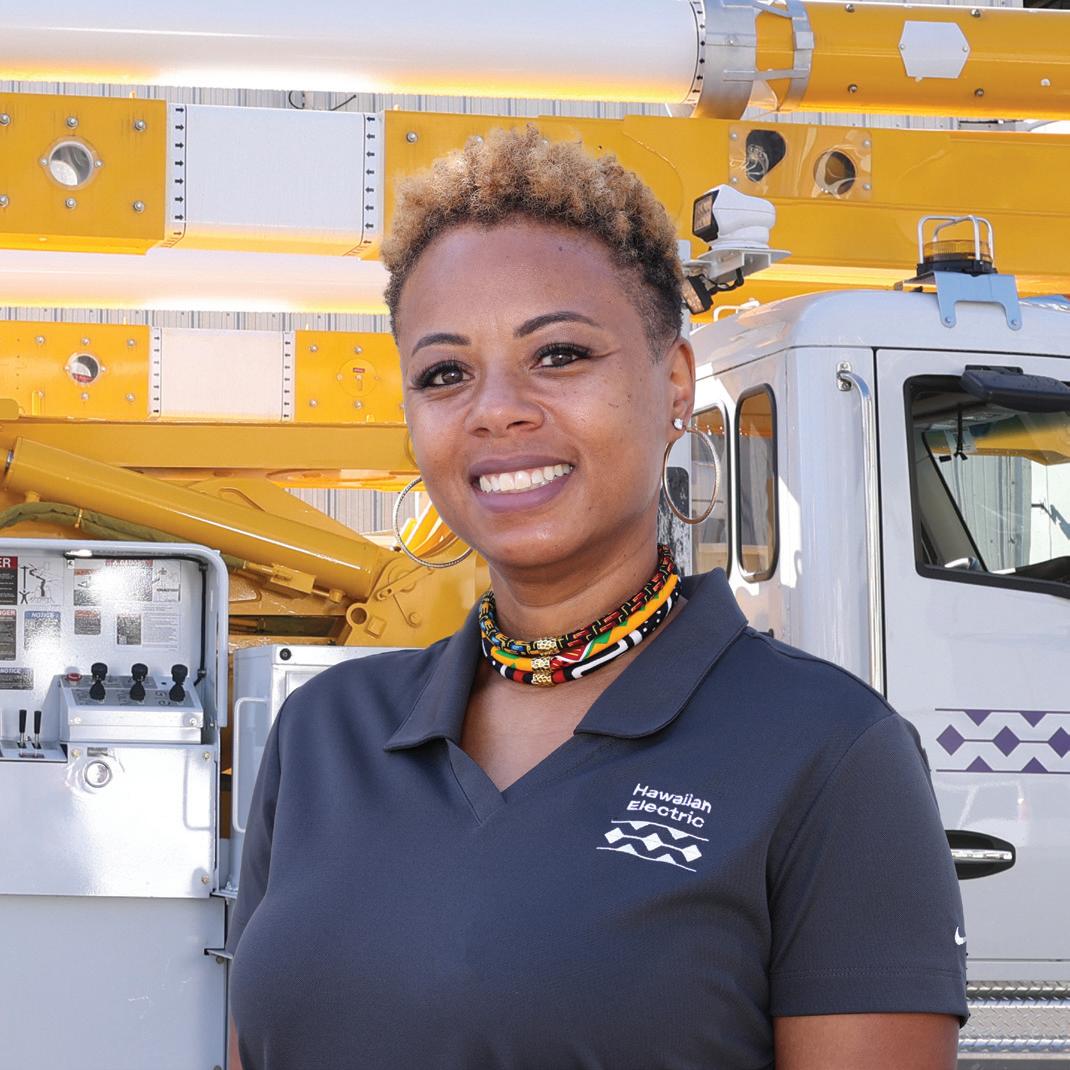
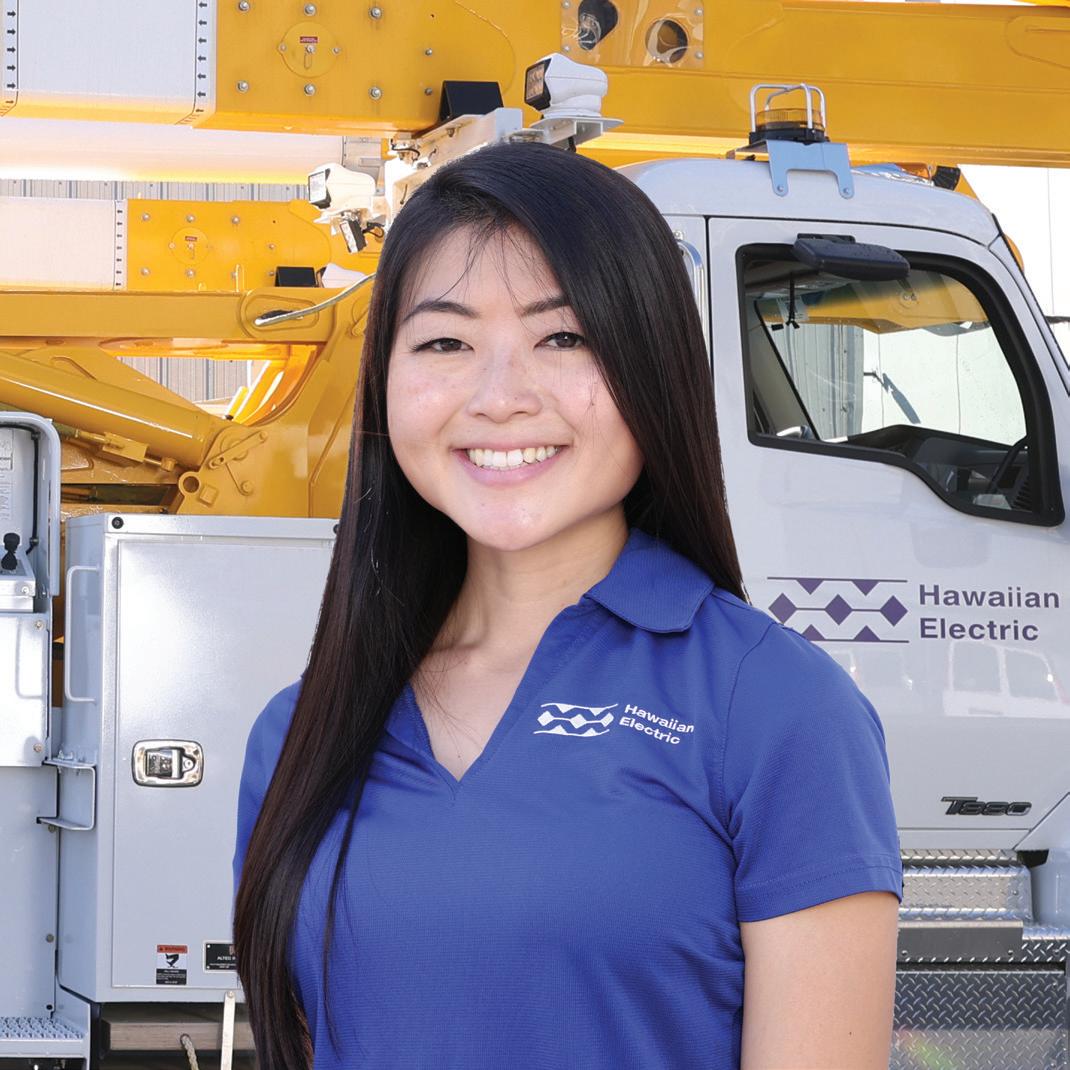
“We have a strong commitment to diversity, equity and inclusion. We want people who aren’t afraid of very ambitious goals and tough challenges.”
Shelee Kimura President and CEO Hawaiian Electric






